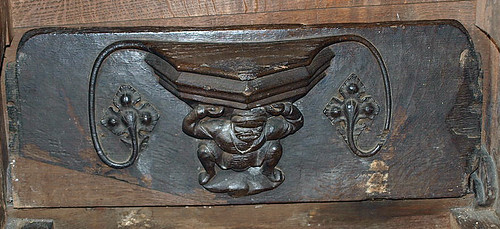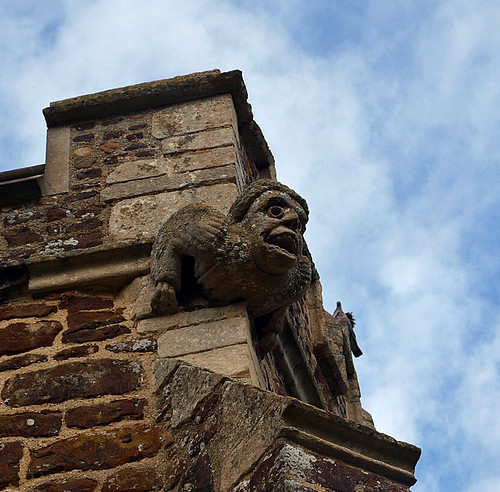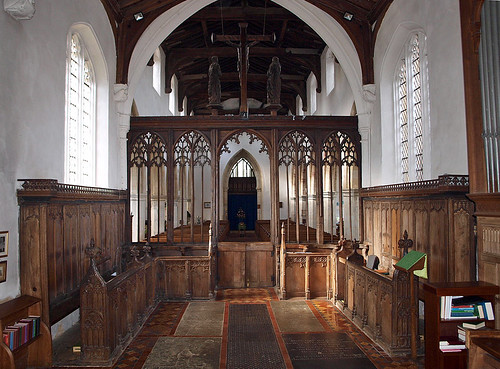ST MARY. The most impressive church in this part of the county. The view to look for is from the N, where indeed the churchyard has not a single tree. So here what meets the eye is architecture entirely, a building of russet stone, with a W tower, a two-storeyed porch, a N transept, and a N sacristy - embattled and enriched by gargoyles below the battlements - an effect robust and sonorous. The effect is entirely due to the C15, it seems, though the N aisle must structurally be much earlier; for it has a lancet window in its N wall and inside a C13 trefoiled, vigorously moulded recess in the wall which is partly cut off by the later transept. Examination will start with the W tower which is designed with much personal character. It has W doorway and window above as one composition, angle buttresses, developing into shallow clasping buttresses at the bell-stage, and the two-light bell-openings surrounded by a big square headed hood-mould or frame. Battlements and a spike. Then the N porch, vaulted inside with diagonal and ridge-ribs, and the N aisle with Late Perp windows. They are the same in the S aisle where the porch is single-storeyed but perhaps even more dramatic because of its tall entrance arch. Most of the transept windows (four lights) are also the same on the N and S sides. The chancel is lower and has a (renewed) five-light E window. The interior somehow lacks the zest of the exterior. Five-bay arcades of octagonal piers of grey stone with double-chamfered arches of buff stone (the latter with much of red colour preserved). The S piers have capitals of simpler moulding than the N piers - indicating probably a slight difference in date. Two-light clerestory windows. - FONT. Octagonal, of Purbeck marble, c. 1200, each side with two shallow blank pointed arches, a type usual in many parts of the country, e.g. in Essex. - ROOD SCREEN. Early Perp, with four-light divisions taken together into two arches under a square head. - W GALLERY. Made up of parts probably of a parclose screen. - BENCHES. S transept, straight-headed, buttressed ends without poppies. - MONUMENT. R. Lane d. 1732 and Mrs Lane d. 1754. Of variously coloured marbles and with pretty Rococo decoration; signed very prominently by E. Bingham of Peterborough.
GAMLINGAY. Its row of snug red almshouses was built in the year of the Great Plague, and the old folk who first lived in them would remember seeing the great fire which destroyed most of Gamlingay in 1600, leaving so little of the prosperous town that its market was transferred to Bedfordshire. But the fire spared the fine little cross-shaped church and in it we came upon three of the great pole hooks which possibly did good service at the time, dragging the thatch ofl the roofs. Its walls of cobbles and richly tinted stone rise from a garden of lawns and flowerbeds, and from the tower rises a spire like a needle.
The church is mostly of the 14th and 15th centuries, and we can sit on coffin lid seats 700 years old to admire the vaulted porch, with roof bosses of three angels. The tall arcades have traces of medieval painting and a tiny peephole through a pillar. The tower arch is small but stalwart, and across the chancel arch is an oak screen with fine tracery from the last years of the 14th century. Next century came the stalls, with arm-rests of animals and birds, angels and a bishop, and misereres with a demon and odd little men. Some of the pews are 500 years old; the font may be 700. Full of life and colour is the modern glass in the east window, showing Christ surrounded by a great company of kings and queens, saints and angels. Some bits of old glass are in a south transept window.
Gamlingay is a cheerful place, its misfortunes quite forgotten, with many a pleasant walk made out of the marshy land drained by Sir William Purchase, who left this village to become Lord Mayor of London but never forgot it. Where three ways meet is a cross with the names of 65 men Gamlingay will not forget.
The church is mostly of the 14th and 15th centuries, and we can sit on coffin lid seats 700 years old to admire the vaulted porch, with roof bosses of three angels. The tall arcades have traces of medieval painting and a tiny peephole through a pillar. The tower arch is small but stalwart, and across the chancel arch is an oak screen with fine tracery from the last years of the 14th century. Next century came the stalls, with arm-rests of animals and birds, angels and a bishop, and misereres with a demon and odd little men. Some of the pews are 500 years old; the font may be 700. Full of life and colour is the modern glass in the east window, showing Christ surrounded by a great company of kings and queens, saints and angels. Some bits of old glass are in a south transept window.
Gamlingay is a cheerful place, its misfortunes quite forgotten, with many a pleasant walk made out of the marshy land drained by Sir William Purchase, who left this village to become Lord Mayor of London but never forgot it. Where three ways meet is a cross with the names of 65 men Gamlingay will not forget.



No comments:
Post a Comment